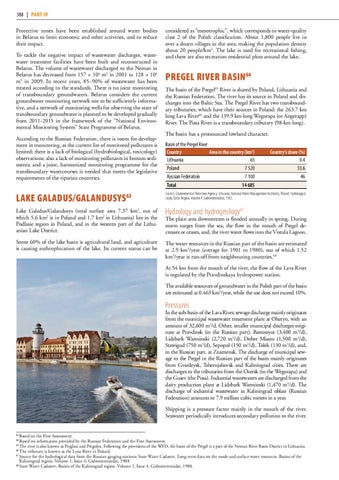388 | PART IV Protective zones have been established around water bodies in Belarus to limit economic and other activities, and to reduce their impact. To tackle the negative impact of wastewater discharges, wastewater treatment facilities have been built and reconstructed in Belarus. The volume of wastewater discharged to the Neman in Belarus has decreased from 157 × 106 m3 in 2001 to 128 × 106 m3 in 2009. In recent years, 85–90% of wastewater has been treated according to the standards. There is no joint monitoring of transboundary groundwaters. Belarus considers the current groundwater monitoring network not to be sufficiently informative, and a network of monitoring wells for observing the state of transboundary groundwater is planned to be developed gradually from 2011-2015 in the framework of the “National Environmental Monitoring System” State Programme of Belarus. According to the Russian Federation, there is room for development in monitoring, as the current list of monitored pollutants is limited; there is a lack of biological (hydrobiological, toxicology) observations; also a lack of monitoring pollutants in bottom sediments; and a joint, harmonized monitoring programme for the transboundary watercourses is needed that meets the legislative requirements of the riparian countries.
considered as “mesotrophic”, which corresponds to water-quality class 2 of the Polish classification. About 1,800 people live in over a dozen villages in the area, making the population density about 20 people/km2. The lake is used for recreational fishing, and there are also recreation residential plots around the lake.
Pregel River Basin64 The basin of the Pregel65 River is shared by Poland, Lithuania and the Russian Federation. The river has its source in Poland and discharges into the Baltic Sea. The Pregel River has two transboundary tributaries, which have their sources in Poland: the 263.7 km long Lava River66 and the 139.9 km long Wegorapa (or Angerapp) River. The Pissa River is a transboundary tributary (98-km long). The basin has a pronounced lowland character. Basin of the Pregel River Country Area in the country (km2) Lithuania 65 Poland 7 520 Russian Federation 7 100 Total 14 685
Country’s share (%) 0.4 53.6 46
Lake Galadus/Galandusys63
Sources: Environmental Protection Agency, Lithuania; National Water Management Authority, Poland; Hydrological study, Baltic Region, Volume 4, Gidrometeoizdat, 1963.
Lake Galadus/Galandusys (total surface area 7.37 km2, out of which 5.6 km2 is in Poland and 1.7 km2 in Lithuania) lies in the Podlasie region in Poland, and in the western part of the Lithuanian Lake District.
Hydrology and hydrogeology67
Some 60% of the lake basin is agricultural land, and agriculture is causing euthrophication of the lake. Its current status can be
The water resources in the Russian part of the basin are estimated at 2.9 km3/year (average for 1901 to 1980), out of which 1.52 km3/year is run-off from neighbouring countries.68
The plain area downstream is flooded annually in spring. During storm surges from the sea, the flow in the mouth of Pregel decreases or ceases, and, the river water flows into the Vistula Lagoon.
At 54 km from the mouth of the river, the flow of the Lava River is regulated by the Pravdinskaya hydropower station. The available resources of groundwater in the Polish part of the basin are estimated at 0.463 km3/year, while the use does not exceed 10%.
Pressures
In the sub-basin of the Lava River, sewage discharge mainly originates from the municipal wastewater treatment plant at Olsztyn, with an amount of 32,600 m3/d. Other, smaller municipal discharges originate at Pravdinsk (in the Russian part), Bartoszyce (3,400 m3/d), Lidzbark Warminski (2,720 m3/d), Dobre Miasto (1,500 m3/d), Stawigud (750 m3/d), Sepopol (150 m3/d), Tolek (130 m3/d), and, in the Russian part, at Znamensk. The discharge of municipal sewage to the Pregel in the Russian part of the basin mainly originates from Gvardeysk, Tshernjahovsk and Kaliningrad cities. There are discharges to the tributaries from the Ozersk (to the Wegorapa) and the Gusev (the Pissa). Industrial wastewaters are discharged from the dairy production plant at Lidzbark Warminski (1,470 m3/d). The discharge of industrial wastewater in Kaliningrad oblast (Russian Federation) amounts to 7.9 million cubic meters in a year. Shipping is a pressure factor mainly in the mouth of the river. Seawater periodically introduces secondary pollution to the river.
Based on the First Assessment. Based on information provided by the Russian Federation and the First Assessment. 65 The river is also known as Preglius and Pregolya. Following the provisions of the WFD, the basin of the Pregel is a part of the Neman River Basin District in Lithuania. 66 The tributary is known as the Lyna River in Poland. 67 Source for the hydrological data from the Russian gauging stations: State Water Cadastre. Long-term data on the mode and surface water resources. Basins of the Kaliningrad region, Volume 1, Issue 4, Gidrometeoizdat, 1988. 68 State Water Cadastre, Basins of the Kaliningrad region. Volume 1, Issue 4, Gidrometeoizdat, 1988. 63
64
